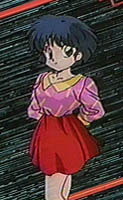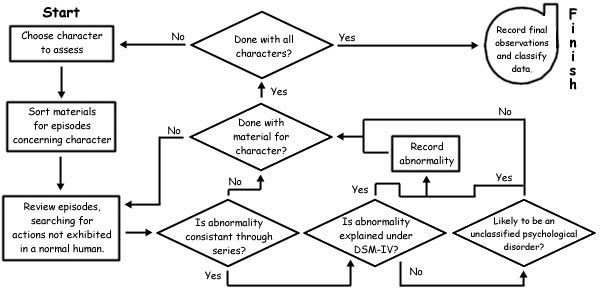Results and Discussion
Many obstacles occured during this study, mostly due to the fact that this was an attempt to apply a scale dealing with "real life" to a fictional work. Many characteristics of the cast are intended to enhance the plot, and it makes little sense to apply DSM-IV in a strict fashion; if this were done, every character would be considered psychotic because they believe in 'impossible' events. Therefore, such 'impossible' events are considered normal, and brief deviations from a character's normal actions for the sake of comedy were ignored. Characters and their cursed selves are treated as one.
Furthermore, a large part of DSM-IV is dependant on time and the ability of a psychologist to interview the patient. Neither of these is present in Ranma 1/2, so it is difficult to say for certain about many of these diagnosis. Some qualities, such as Ranma's Dragon's Whisker, disapper partway through the series; they may or may not be included depending on the condition. Fianlly, Axis III and IV should be numericaly coded, but appropriate systems were not found.
Ranma Saotome / Ranko Tendo

Source: Ranma 1/2 opening, "Niji to Taiyô no Oka"
("Between the Rainbow and the Sun") |
Axis I |
302.85 Gender Identity Disorder in Adolescents,
In Partial Remission
300.29 Specific Phobia, Animal Type (Cats), Severe,
Affecting Dissociative Identity Disorder
300.14 Dissociative Identity Disorder
V61.20 Parent-Child Relational Problem, Affecting
Gender Identity Disorder
V61.1 Partner Relational Problem, Severe
V62.3 Academic Problem
V62.4 Acculturation Problem In Full Remission, Mild |
| Axis II |
V71.09 No Diagnosis |
| Axis III |
Jusenkyo curse
Rapid and virtually unlimited growth of hair
Rapid healing |
| Axis IV |
Unease around and refusal to fight females |
| Axis V |
GAF 75 |
Let us begin our examination with Ranma. Virtually anyone else in Ranma's position in life would rapidly develop a number of psychological afflictions; it is surprising how few Ranma has.
When faced with the loss of something as deeply rooted as gender, gender identity disorder is not something remarkable, but rather expected. Of course, there are extremely few documented precedents of a boy unwillingly changing into a girl during adolescence, but some parallels can be drawn to cases of accidental castration and to babies born with indeterminate sex. In those cases, rejection of the new gender role is not unheard of, and has prompted many a study on gender.
The criteria for Gender Identity Disorder consists of four items. According to DSM-IV Made Easy, they are:
- The patient strongly and consistantly identifies with the other sex.
- There is strong discomfort with the patient's own sex.
- There is no physical intersex condition.
- Symptoms impair work, social, of personal functioning.
Now consider Ranma. As a girl, Ranma frequently denies being female, especially after trauma. Although Ranma-chan is not overly uncomfortable with 'her' gender, this is due to the fact that 'she' can resume male form at any time. When this avenue of escape is prevented, Ranma becomes distraught. View, for example, the "Cat's Tounge" storyline (Takahashi, "Cold Competition"). Ranko attempts to immerse herself in painfully hot water because of her disbelief that she is 'permanently' female. This example is even clearer because Ranko's attempts are repeated, despite obvious evidince that hot water is dangerous to her and not helping.
Another time Ranma cannot become male is when Nodoka Saotome visits. This is more of a psychological cause than physical, and increases Ranko's stress due to the fact that she can, in fact, revert to male status. During one visit, Nodoka makes a casual comment about Ranko's suitability as a wife (Takahashi, "Like Water For Ranma"). Ranko's discomfort is obvious; despite the fact that her life depends on how well she can act, Ranko cannot surpress a shudder.
One final example of Ranma's discomfort occurs when he fights Herb of the Musk Dynasty. Herb uses the Chiisuiton to freeze Ranma in female form; again, Ranma is quite visably 'upset'.
The third criteria is met once the word "intersex" becomes clear. "Intersex" merely refers to people who have both male and female reproductive tissues. It should be noted that people who have undergone gender reassignment surgury are not considered to be intersexed; thus, being intersexed would require both male and female reproductive tissues to be present at the same time, which is not the case for Ranma. The last criteria for gender identity disorder is easily verified, as Ranma's obsession to prove his masculinity has often led him to actions he might otherwise have chosen not to make.
Ranma's gender identity disorder is strongest after he becomes cursed, however he slowly becomes accustomed to his gender (of the moment), male or female. This is accelerated by Nodoka's eventual acceptance of Ranma's curse. In view of this, the disorder is "In Partial Remission".
The diagnoses "Specific Phobia, Animal Type (Cats), Severe" should be obvious. As there can be no doubt about the validity of Ranma's aluirophobia, first seen in Takahashi's "Cat-fu Fighting", specific reasons are not enumerated. The phobia is extreme, even taking anime standards into account. Ranma's mind 'snaps' and he assumes a different personality; therefore the aluirophobia affects, and is in fact the trigger for, Dissociative Identity Disorder. Alternate personalities are generally brought out suddenly, preceded by stress, and leave no memories of events ( Morrison 325), which is certainly the case with Ranma.
In no way can Ranma's upbringing be considered normal, especially considering his father. Genma's strongly voiced opinions about the shortcomings of the 'fairer sex' and the importance of 'manliness' made an impression on young Ranma, and he must come to terms with being a "mere" girl half the time. With nearly any other childhood, it is likely that Ranma would have accepted his curse; instead, finding a cure is one of the prime goals in Ranma's life. Nodoka does not help matters either, bringing the threat of seppuku with her every time she visits.
Genma Saotome / Mr. Panda
Nodoka Saotome
Ryoga Hibiki / P-chan
| Axis I |
V62.3 Academic Problem |
| Axis II |
301.0 Paranoid Personality Disorder (Principal Diagnosis)
301.22 Schizotypal Personality Disorder |
| Axis III |
Jusenkyo curse
Rapid healing |
| Axis IV |
Lack of directional sense, Severe,
Affecting Academic Problem and
Schizotypal Personality Disorder
Unease around females, Severe |
| Axis V |
GAF 60 |
Ukyo Kounji

Source: Ranma 1/2 OAV opening, "Where Do We Go From Here?" |
Axis I |
|
| Axis II |
|
| Axis III |
|
| Axis IV |
|
| Axis V |
GAF |
Tsubasa Kurenai
Akane Tendo

Source: Ranma 1/2 opening, "Chikyô Orchestra" |
Axis I |
|
| Axis II |
301.0 Paranoid Personality Disorder
301.50 Histrionic Personality Disorder |
| Axis III |
|
| Axis IV |
|
| Axis V |
GAF |
Nabiki Tendo

Source: Ranma 1/2 opening, "Little Date" |
Axis I |
|
| Axis II |
301.20 Schizoid Personality Disorder, Principal Diagnosis |
| Axis III |
|
| Axis IV |
|
| Axis V |
GAF |
Kasumi Tendo

Source: Ranma 1/2 OAV closing, "Red Shoe Sunday" |
Axis I |
V71.09 No Diagnosis |
| Axis II |
V71.09 No Diagnosis |
| Axis III |
None |
| Axis IV |
None |
| Axis V |
GAF 100 |
Under no circumstances would Kasumi be the subject of a psychological examination, with the doubtful exception of a case study. She is a perfect example of a 100 on the GAF scale, having "Superior functioning in a wide range of activities, life's problems never seem to get out of hand, is sought by others because of ... her many positive qualities. No symptoms" ( Morrison 581)
Soun Tendo
Dr. Tofu Ono
Xian Pu / Cat
Mu Tsu / Duck
Khu Lon
Happosai
Tatewaki Kuno
| Axis I |
295.30 Schizophrenia, Undifferentiated Type
297.3 Shared Psychotic Disorder |
| Axis II |
301.4 Obsessive-Compulsive Disorder |
| Axis III |
None |
| Axis IV |
None |
| Axis V |
GAF 12 |
Kodachi Kuno
Principal Kuno
Gosunkugi Hikaru
Ms. Hinako Ninomiya
Shinnosuke
The following characters deserve classification, but I do not feel comfortable doing so. Therefore, they have a temporary classification of:
| Axis I |
799.9 Diagnosis Deferred |
| Axis II |
799.9 Diagnosis Deferred |
| Axis III |
None |
| Axis IV |
None |
| Axis V |
GAF 0 - Inadequte Information |
Saffron
Ryu Kumon
Pansuto Taro
Rouge
Mariko Konjo
Herb
Mint
Lime





